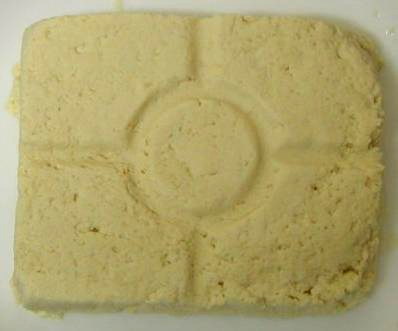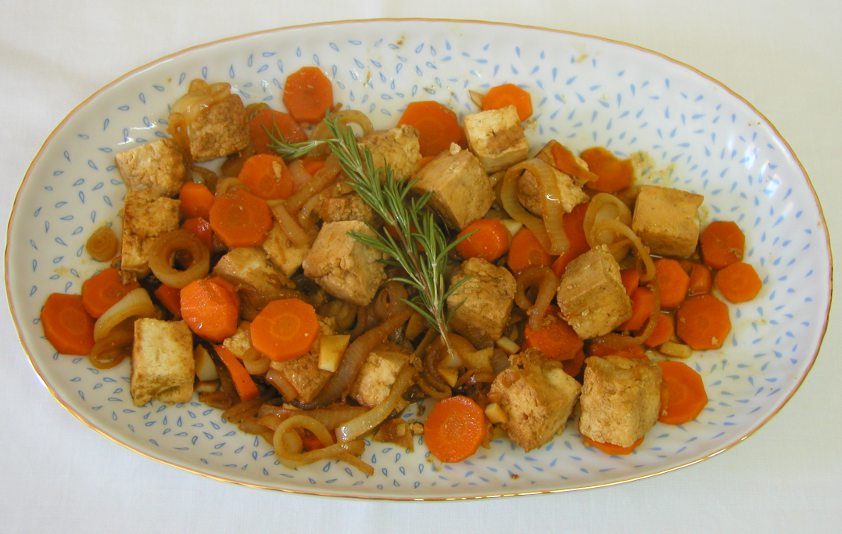


Also known as soya cheese, tofu is a food obtained from the coagulation of "Soymilk," in a process similar to coagulation of cow milk to obtain the cheese. It is an excellent source of nutrients, including vitamins and minerals, with important functional properties. It has a smooth texture and a relatively neutral flavor. Thus, it is very versatile in the kitchen and a source of vegetable protein low in fat. It is also cholesterol-free and inexpensive.
Tofu was invented in China, more than two thousand years ago. It was introduced in Japan by Buddhist monks around the year 600. It used to be consumed only by the upper classes of Japanese society, mostly monks and nobles. Currently, it is one of the most popular food products in Japan. In the West, the interest in tofu is increasing, associated with an increasing awareness and healthy eating habits. It has caught public attention mostly during the 1960s and its popularity grew fast as the benefits of soy and its derivatives were also discovered. Tofu is now seen by most Europeans and Americans as a normal source of protein and routinely used as part of a balanced healthy diet. In the United States of America there is now an annual festival of tofu.
Tofu is very healty. It is easily digested. Yet, it is low in calories - only 76Kcal for 100g. It is a good source of protein (100 g contain 8.5 g of protein). Thus, it is an excellent choice for weight loss diets or people struggling to maintain weight. Tofu is rich in iron, copper, selenium, calcium and manganese. Iron plays a fundamental role, together with copper, in the synthesis of hemoglobin. Copper, manganese and selenium have antioxidant functions, which make them good allies in protecting against cancer. Tofu is a better source of calcium if calcium sulfate is used as the coagulating agent. It also contains a wealth of phytochemicals, especially phytoestrogens (isoflavones), which give the tofu numerous health protective properties. Besides, it is very low in saturated fat, less than 1g per 100g. It is a good source of omega-3 and cholesterol-free.
The phytochemicals found in tofu make it useful as protective in various types of cancer, such as breast, rectum and prostate cancer. The isoflavones found in tofu also have protective effects in pre and postmenopausal women, minimising the effects of “hot flashes,” reducing the incidence of osteoporosis by promoting reabsorption of calcium in the bone and so preventing loss of bone density. Although there is still insufficient data to define recommendations about intake of isoflavones, there is evidence that daily intake of 25 to 50 mg of isoflavones contributes to reducing these three types of cancer. Tofu has 33.7 mg of isoflavones per 100g. Consumption of soy and soy derivatives are also associated with decreased risk of heart disease, by contributing to reduce "bad" cholesterol and triglycerides, and increaseing "good" cholesterol, which is one of the factors by which cardiovascular function is improved. Those effects are due mainly to the contribution of omega-3. In the U.S., soy products are allowed to claim that “consuming 25g of soy protein has positive effects in lowering cholesterol.”
Tofu is as an excellent meat substitute, protecting human health and the environment.
 Tofu is a versatile food. It can be used as a meat substitute or only added to the daily food as an alternative healthy source of protein and other nutrients. Having a relatively neutral flavour, it is able to easily absorb the flavours of the other ingredients. The different textures and flavours available allow a variety of usage options. Tofu can be served as an entry, in salads, as a sauce, as pates, as a main dish, in sandwiches or in desserts. Tofu can also be made at home. There are kits for home production: using soy milk and a coagulant, which can be nigari, vinegar or lemon, among others, it is possible to make tofu (softer or firmer) for about half the price of the industrial tofu.
Tofu is a versatile food. It can be used as a meat substitute or only added to the daily food as an alternative healthy source of protein and other nutrients. Having a relatively neutral flavour, it is able to easily absorb the flavours of the other ingredients. The different textures and flavours available allow a variety of usage options. Tofu can be served as an entry, in salads, as a sauce, as pates, as a main dish, in sandwiches or in desserts. Tofu can also be made at home. There are kits for home production: using soy milk and a coagulant, which can be nigari, vinegar or lemon, among others, it is possible to make tofu (softer or firmer) for about half the price of the industrial tofu.
References:
- Pauletto, Fernanda Bortoluzzi. Fogaça, Aline de Oliveira. Avaliação da composição centesimal de tofu e okara. Disc. Scientia. Série: Ciências da Saúde, Santa Maria, v. 13, n. 1, p. 85-95, 2012
- Benassi, Vera de Toledo. Felberg, Ilana, Alvarenga, André Luis Bonnet., Mandarino, José Marcos Gontijo.Tofu. Brasília, DF : Embrapa Informação Tecnológica,2007. 39 p. : il. - (Coleção Agroindústria Familiar).
- BORDIGNON, J.R.; CARRÃO-PANIZZI, M.C.; MANDARINO, J.M.G.M. Mais saúde em sua vida cozinhando com tofu. Londrina : Embrapa Soja, 2000.
- http://www.rgnutri.com.br/sqv/saude/tofu.php
- N., Yakubu.,G., Oboh. AA., Olalekan. Antioxidant and Hepatoprotective Properties of Tofu (Curdle Soymilk) against Acetaminophen-Induced Liver Damage in Rats. Biotechnol Res Int. 2013;2013:230142. doi: 10.1155/2013/230142. Epub 2013 Feb 28.
Insert date: 2013-07-09 Last update: 2013-07-31
Comment
![]()
![]()
Other foods
Authors > Contributor writers > Cláudia Maranhoto
Authors > Translators > Carolina Freitas